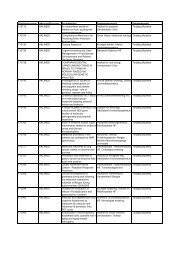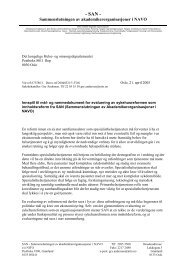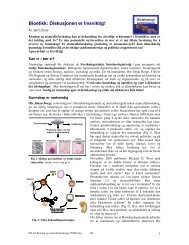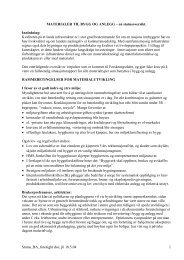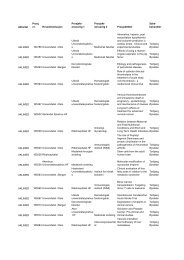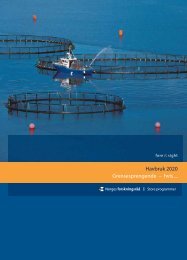A Revolution in R&D
A Revolution in R&D
A Revolution in R&D
Create successful ePaper yourself
Turn your PDF publications into a flip-book with our unique Google optimized e-Paper software.
54<br />
other—often literally—on collaborative projects or<br />
<strong>in</strong> formal discovery partnerships. And genetics<br />
requires far closer collaboration between basic<br />
research and development than ever before.<br />
One excellent example of reth<strong>in</strong>k<strong>in</strong>g traditional<br />
organizational structure and boundaries is<br />
GlaxoSmithKl<strong>in</strong>e. Alert to the impact of scale, the<br />
company has on the one hand consolidated functions<br />
where scale and coord<strong>in</strong>ation provide a clear<br />
advantage, and on the other, engaged <strong>in</strong> decentraliz<strong>in</strong>g<br />
where size and complexity could prove a drawback.<br />
Specifically, prompted by the scale benefits,<br />
the company decided to organize centrally both the<br />
front end and the back end of R&D (that is, target<br />
discovery and full development). For the steps <strong>in</strong><br />
between, conversely, where the company’s enormous<br />
scale would risk encumber<strong>in</strong>g <strong>in</strong>novation, it<br />
has established smaller, more autonomous centers<br />
of excellence (based on different therapeutic<br />
areas), which attempt to simulate the feel of smaller<br />
biotech companies.<br />
The Entire Corporation. So, enhanced control of data<br />
and <strong>in</strong>creased cross-functionality of personnel are<br />
set to change the structure and tone of the R&D<br />
department. But their sphere of operation is<br />
broader than that. As with the strategic issues discussed<br />
earlier, the company as a whole is implicated.<br />
New l<strong>in</strong>es of communication, and possibly<br />
new cha<strong>in</strong>s of command, will need to be extended<br />
between R&D and other units. In particular, the<br />
relationship between R&D and market<strong>in</strong>g will be<br />
fundamentally transformed: with R&D fac<strong>in</strong>g<br />
greater choice and plac<strong>in</strong>g bigger bets earlier than<br />
ever, commercial <strong>in</strong>put will be crucial. And pharmacogenetics<br />
will require new ways of th<strong>in</strong>k<strong>in</strong>g<br />
about markets, competitors, and customers. (Pharmacogenetics<br />
may also <strong>in</strong>spire new l<strong>in</strong>kages<br />
between pharmaceutical and diagnostic units for<br />
corporations that have both).<br />
Coord<strong>in</strong>at<strong>in</strong>g the commercialization process<br />
between R&D and market<strong>in</strong>g has always been a delicate<br />
balanc<strong>in</strong>g act. Most biopharmaceutical companies<br />
have established product development project<br />
teams to drive the process. These cross-<br />
functional teams are charged with develop<strong>in</strong>g product<br />
strategy and coord<strong>in</strong>at<strong>in</strong>g the various functions<br />
as products progress from R&D <strong>in</strong>to the market.<br />
The job has now become even more complex and<br />
tricky, ow<strong>in</strong>g to larger global efforts, greater <strong>in</strong>formation<br />
flow, more specialized functions, and<br />
<strong>in</strong>creased liaison with global strategic market<strong>in</strong>g<br />
(especially when companies consider the options<br />
for apply<strong>in</strong>g pharmacogenetics to molecules <strong>in</strong><br />
development).<br />
Beyond the Corporation. F<strong>in</strong>ally, new partnership<br />
models need to be considered. Although traditionally<br />
organized partnerships are still appropriate <strong>in</strong><br />
many cases, new and more flexible forms of alliance<br />
will sometimes be required, notably when it comes<br />
to collaborat<strong>in</strong>g with academic or not-for-profit<br />
<strong>in</strong>stitutions and to jo<strong>in</strong><strong>in</strong>g horizontal networks or<br />
consortia.<br />
R&D Governance<br />
One potential source of ga<strong>in</strong> <strong>in</strong> R&D is improved<br />
decision mak<strong>in</strong>g. Consider aga<strong>in</strong> the example at the<br />
start of the value cha<strong>in</strong>—the glut of identified targets<br />
and the need to decide which ones should proceed<br />
to the next phase. Genomics technologies<br />
have created this quandary, but they have also provided<br />
the means for solv<strong>in</strong>g it. Us<strong>in</strong>g new genomic<br />
methods of “aptitude-test<strong>in</strong>g,” decision makers can<br />
confidently preselect the most promis<strong>in</strong>g targets<br />
and forward them downstream.<br />
Even decisions unrelated to genomics technologies<br />
stand to improve, s<strong>in</strong>ce the new genomics regimen<br />
fosters a culture of rigorous selection criteria. In<br />
fact, one of the most important, though perhaps<br />
least noted, benefits of genomics is the way it<br />
encourages a thorough reth<strong>in</strong>k<strong>in</strong>g of decisionmak<strong>in</strong>g<br />
processes. New k<strong>in</strong>ds of data now present<br />
themselves for <strong>in</strong>terpretation, and they enter the<br />
calculations earlier and <strong>in</strong> greater abundance than<br />
the old k<strong>in</strong>ds did. And R&D decision makers have<br />
to take <strong>in</strong>to account a new set of factors too, beyond<br />
the conf<strong>in</strong>es of R&D, <strong>in</strong> order to maximize<br />
value—factors such as market<strong>in</strong>g and IP implications,<br />
for example.



